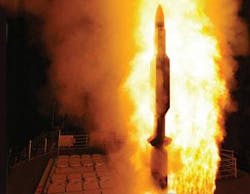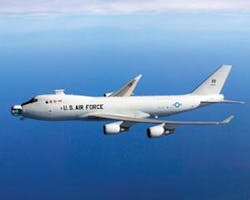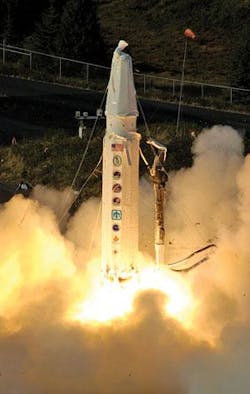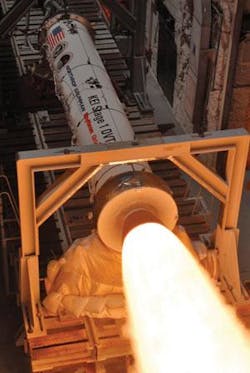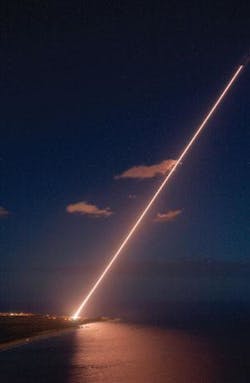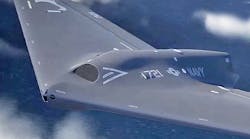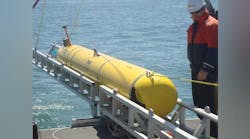The key to any successful missile-defense shield is the ability of the sensors to track the missile accurately. Recent missile tests prove that an effective missile-defense shield is closer than ever before.
By John McHale
More and more nations with uncertain motives are launching missile programs, which makes it essential that the U.S. military field a ballistic missile-defense system (BMDS) able to destroy incoming missiles whether in boost phase, midcourse, or terminal phase.
“A global and integrated BMDS relies on a network-centric capability that shares information from various land, air, or space-based sensors, provides this information to an integrated fire control system to calculate solutions for the interceptors, and then distributes this information to appropriate interceptors for an effective kill,” according to U.S. Missile Defense Agency (MDA) documents.
The sensors—radar, lasers, infrared, etc.—are the beginning of this network. Some of the sensors, such as the 25-year-old AN/SPY-1 radar, have been around for decades, but when combined with state-of-the-art network-centric technology and signal-processing systems they have achieved unprecedented success.
Aegis and AN/SPY-1
A recent example is Lockheed Martin’s Aegis Ballistic missile-defense (BMD) weapon system, which with the AN/SPY-1 radar intercepted and destroyed two non-separating, short-range ballistic missile targets nearly simultaneously last month in Kauai, Hawaii. The test marked the first successful attempt by any U.S. ballistic missile-defense system at dual exo-atmospheric intercepts—shooting down missiles in space—says Ken Ross, spokesman for Lockheed Martin. The test also represents the Aegis BMD system’s 10th and 11th successful ballistic missile intercepts in 13 attempts.
This test destroyed the missiles in the midcourse phase, Ross says. The Aegis has shot down targets in each phase of flight from ascending to descending, he adds. The reliability of the durable AN/Spy-1 radar system combined with the system’s advanced technology make it the most efficient naval surface defense system around today, Ross says.
The midcourse phase is that portion of a ballistic missile’s trajectory between the boost phase and the reentry phase when reentry vehicles and penetration aids travel at ballistic trajectories above the atmosphere. During this phase, a missile releases its warheads and decoys and is no longer a single object, but rather a swarm of reentry vehicles and penetration aids falling freely along present trajectories in space.
In the November test, the U.S. Navy guided missile cruiser USS Lake Erie, an Aegis BMD vessel equipped with the latest U.S. Navy-certified version of the Aegis BMD Weapon System (Aegis BMD 3.6), guided two SM-3 Block IA missiles to intercept two ballistic missile targets outside the Earth’s atmosphere.
“With two targets engaged simultaneously, both the system and crew are under additional stress and they performed flawlessly,” says Orlando Carvalho, vice president and general manager of Lockheed Martin’s Surface-Sea Based Missile Defense line of business in Cherry Hill, N.J. “With Aegis, we build a little, test a little, and learn a lot. The test is the 12th planned flight mission to methodically and incrementally fully verify the Aegis BMD capability. ”
The SPY-1 radar, augmented by the Aegis BSP signal processor, which is in development and will be installed in Aegis BMD ships beginning in 2010, provides an advanced discrimination capability to defeat more complex ballistic missile threats. The Aegis BSP is an open-architecture design, allowing for quick and affordable upgrades as the signal processor technology evolves.
The move to open architecture for Aegis BMD is in parallel and aligned with the Navy’s Aegis Open Architecture (OA) initiative to transform the (non-BMD) Aegis Weapon System to an open-architecture system, beginning with the Cruiser Modernization Program now underway. BMD capability will be included in modernized, OA Aegis cruisers and destroyers starting in 2012.
The new SPY-1D(V) radar is designed for improved performance in demanding littoral environments under the Cruiser Modernization Program. This version will have multi-mission capability, Ross says.
Employing lessons learned from real-life tactical operations, this system adds sophisticated coded waveforms, Pulsed Doppler acquisition and track, and a new track initiation processor to improve clutter rejection substantially—especially in littoral applications.
The MDA and Navy are developing Aegis BMD as part of the U.S. BMDS. Nine U.S. Navy Aegis-equipped warships have the ability to conduct long-range search and track and engage ballistic missiles. Another seven Aegis warships are equipped with Aegis BMD long-range surveillance and track capability. Ultimately 15 Aegis destroyers and three Aegis cruisers will be outfitted with the ability to engage short to intermediate range ballistic missile threats and support other BMDS engagements using the Aegis BMD Weapon System and the SM-3. Japan has purchased Aegis BMD capability for their Kongo-class Aegis destroyers.
The Aegis Weapon System is the foundation for Aegis BMD. Individual elements of this system are modified to perform ballistic missile-defense functions based on system requirements derived from BMDS requirements by Lockheed Martin’s engineering staff. These elements include the AN/Spy-1 radar, weapons control, command and decision, MK 41 Vertical Launch System, and SM-3 Block IA missiles. The Aegis BMD Weapon System also integrates with the BMDS, receiving track data from and providing track information to other BMDS elements.
Aegis is deployed on 83 ships around the globe with more than 20 additional ships planned or under contract. In addition to the U.S. and Japan, Aegis is the maritime weapon system of choice for South Korea, Norway, Spain, and Australia.
Sea-based X-band radar
Another key radar sensor for missile defense is the Raytheon-developed X-Band Radar (XBR) portion of the Sea-Based X-Band Radar, which has also destroyed missiles in midcourse phase as part of the Ground Based Midcourse Defense (GMD) element of the Ballistic Missile-Defense System (BMDS).
GMD is a major element of the Ballistic Missile-Defense System, and Boeing Integrated Defense Systems is the prime contractor for GMD and SBX.
XBR will provide missile tracking, discrimination, and hit assessment to the GMD portion of the BMDS being developed by the MDA. The XBR will help discriminate the hostile warhead from the decoys and countermeasures, providing additional capability for interceptor missiles to protect the U.S. and its friends and allies from ballistic missile attacks.
The SBX Radar is a combination of an advanced X-band radar with a mobile, ocean-going, semi-submersible platform. The vessel is a high-tech, fifth-generation semi-submersible oil drilling platform. It is twin-hulled, self-propelled, and stable in high winds and turbulent sea conditions.
Aboard the maneuverable SBX, the XBR can be positioned in the ocean to support testing and provide radar coverage for possible threat missile launches throughout the world and is a critical component of the missile-defense system.
The ocean-spanning mobility of the SBX enables the radar to be repositioned as needed to support the various test scenarios envisioned for the BMDS or to provide an advanced radar capability to obtain missile tracking information while an incoming threat missile is in flight, discriminate between the hostile missile warhead and any decoys, and provide that data to interceptor missiles so that they can intercept and destroy the threat missile before it can reach its target.
The SBX is 240 feet wide and 390 feet long. It towers more than 280 feet from its keel to the top of the radar dome and displaces nearly 50,000 tons. Larger than a football field, the main deck houses living quarters, workspaces, storage, power generation, a bridge, and control rooms while providing the floor space and infrastructure necessary to support the radar antenna array, command control and communications suites, and an In-flight Interceptor Communication System Data Terminal which provides missile tracking and target discrimination data to interceptor missiles. The Sea-Based X-Band Radar will be manned by approximately 85 crew members.
Airborne Laser
Perhaps the MDA’s most famous program, the Airborne Laser (ABL) is designed to destroy missiles in their boost phase.
The boost phase is the first phase of a ballistic missile trajectory during which it is being powered by its engines. During this phase, which usually lasts three to five minutes for an ICBM, the missile reaches an altitude of about 200 kilometers whereupon powered flight ends and the missile begins to dispense its reentry vehicles. The other phases of missile flight, including midcourse and terminal, take up the remainder of an ICBM’s flight time of 25 to 30 minutes.
The operational phase of the ABL begins with the six strategically placed infrared sensors that detect the exhaust plume of a boosting missile. Once a target is detected, a kilowatt-class laser, the Track Illuminator (TILL), tracks the missile and determines a precise aim point. The Beacon Illuminator (BILL), a second kilowatt-class laser, then measures disturbances in the atmosphere, which are corrected by the adaptive optics system to accurately point and focus the high energy laser at its intended target. Using a very large telescope located in the nose turret, the beam control/fire control system focuses the megawatt-class laser beam onto a pressurized area of the boosting missile, holding it there until the concentrated energy causes the missile to break apart, according to the MDA.
Contrary to what many may think, the ABL high-energy laser will not blow up the laser, but heat to such an extent that it implodes. This summer the Boeing-led ABL team actively tracked an airborne target, compensated for atmospheric turbulence, and fired a surrogate for its high-energy laser.
During the test, the modified Boeing 747-400F took off from Edwards Air Force Base, Calif., and used its infrared sensors and its TILL to find and track an instrumented target board located on the U.S. Air Force’s NC-135E Big Crow test aircraft. The Big Crow then fired its beacon laser at the ABL aircraft to allow ABL to measure and compensate for laser beam distortion caused by the atmosphere. Finally, ABL fired the surrogate high-energy laser (SHEL) at the Big Crow target board to simulate a missile shootdown. With the exception of ABL’s BILL, this flight test demonstrated the entire engagement sequence from target acquisition to pointing and firing the SHEL.
“This successful test shows that ABL can find and track a target, use its beam control/fire control system to compensate for atmospheric turbulence, and fire a surrogate high-energy laser to simulate a missile intercept,” says Pat Shanahan, vice president and general manager of Boeing Missile-Defense Systems. “We have now demonstrated most of the steps needed for the Airborne Laser to engage a threat missile and deliver precise and lethal effects against it.”
ABL fired the TILL at the Big Crow target board for the first time last spring. This test demonstrated ABL’s ability to transition from passive tracking of a simulated missile plume to active tracking, by “walking” the TILL beam to the nose of the missile and using the TILL light returning from the edge of missile for precision tracking and determination of where to point the SHEL on the target. In addition, atmospheric turbulence compensation was performed concurrent with active tracking and SHEL firing.
The TILL, built by Raytheon Space and Airborne Systems (SAS) in El Segundo, Calif., has been fired more than 50 times for periods of as long as 90 seconds since in-flight tests began in January. The illuminator has been fired more than 900 times since installation on the aircraft for ground tests that began in 2006. It has conducted more than 140 million pulsed laser shots.
The kilowatt-class illuminator is used to track a boosting ballistic missile. Raytheon created the illuminator as a major supplier to Lockheed Martin, which provides the ABL Beam Control/Fire Control segment.
In upcoming flight tests, ABL will again demonstrate the engagement sequence, but this time use the return from its BILL instead of the Big Crow’s beacon laser to measure atmospheric distortion.
The program will install the actual Northrop Grumman-built high-energy laser in the aircraft to prepare for the first intercept test against an in-flight ballistic missile in 2009. The high-power chemical laser has completed rigorous ground testing at Edwards Air Force Base and is being prepared for installation, Boeing officials say.
Boeing is the prime contractor for ABL, which will provide a speed-of-light capability to destroy all classes of ballistic missiles in their boost phase of flight. Boeing provides the modified aircraft and the battle management system and is the overall systems integrator. ABL partners are Northrop Grumman, which supplies the high-energy laser and the beacon illuminator laser, and Lockheed Martin, which provides the nose-mounted turret and the beam control/fire control system.
Patriot
The U.S. military’s first operational hit-to-kill missile-defense system—the Patriot—is receiving an upgrade to its radar as well as other system hardware.
Raytheon in Tewksbury, Mass., will soon be starting the Patriot “Pure Fleet” modernization program, bringing all Army Patriot equipment for the U.S. Army to state-of-the-art Patriot Configuration 3 status.
The Army is responsible for production and further development of Advanced Capability-3 System and the Medium Extended Air Defense System; the MDA remains responsible for the Ballistic missile-defense System interoperability and integration efforts.
Raytheon will provide hardware upgrades to four Patriot radars, engagement control stations and launchers, as well as enhanced logistics capability through support to a common configuration. Work will be performed at Raytheon’s Integrated Air Defense Center in Andover, Mass.
The Patriot system, which gained fame during the first Gulf War for its ability to destroy Iraq’s SCUD missiles, destroys incoming targets in their terminal phase. The terminal phase is “that final portion of a ballistic missile’s trajectory between the midcourse phase and trajectory termination,” according to the MDA.
The initial contract provides for the upgrade of one battalion consisting of four fire units of Patriot hardware. “Pure Fleet” is the result of the Army’s decision in February 2006 to upgrade additional tactical Patriot fire units.
“Upgrading Patriot fire units from Configuration 2 to Configuration 3 will enhance the system’s capabilities to meet current and emerging threats,” says Pete Franklin, vice president, National & Theater Security Programs for Raytheon Integrated Defense Systems.
MDA revises MKV goals for 2008
MDA officials revised the goals for the Multiple Kill Vehicle (MKV) Program in their 2008 budget request. The MKV payload is an evolutionary upgrade for all of the BMDS midcourse elements, and is an integral component of a broad BMDS strategy for addressing the expected utilization of complex countermeasures by potential adversaries.
For the FY 08 budget, MKV’s goals include expanding volume kill capability to include land- and sea-based options; maximizing commonality and modularity of kill vehicle components; consolidating BMDS multiple and unitary kill vehicle design and development efforts; and lowering schedule and technical risk.
To achieve these goals, MDA officials say “they will pursue a common MKV approach across the BMDS by providing an open technology and architectural standard for two complementary and competing development efforts. Our plan is to employ a single integrated management structure to develop land- or sea-based systems with multiple and unitary kill vehicle capabilities that take advantage of the open architecture for future growth.”
The first development path will focus on the development of a carrier vehicle that can transport multiple smaller kill vehicles. The carrier vehicle will perform several functions, such as releasing several small individual kill vehicles; providing information to ground- or space-based sensors and the associated algorithms with the information provided with its infrared sensor; communicating information to the individual kill vehicles and to the other midcourse elements, including Ground Midcourse Defense, Kinetic Energy Interceptor, and the Aegis Ballistic missile-defense System; reviewing the results of the engagement and assisting with the kill assessment; and acting as a kill vehicle and intercepting the threat object itself.
The second development path adds flexibility to the first path and will use different technology but the same common architecture and standards, MDA officials say. This path will focus on developing a dispenser with multiple kill vehicles, one of which is designated as the lead kill vehicle. The lead kill vehicle provides most of the same essential functions as the Carrier Vehicle discussed above, including assigning the other kill vehicles to threat objects. In this approach, any of the other kill vehicles can assume the lead mission should the lead kill vehicle malfunction, providing redundancy and enhanced mission assurance.
Raytheon to provide sensor netting technology
U.S. Department of Defense (DOD) officials are purchasing the Raytheon Solipsys Tactical Component Network (TCN) technology under a $45.5 million contract for sensor fusion and advanced networking technology.
“TCN provides a critical warfighting capability in the form of a sensor netting framework to achieve a single integrated picture and joint interoperability,” says Mark Trenor, president of Raytheon Solipsys in Fulton, Md. “TCN also provides a path forward for a joint framework to support an interoperable ‘plug-and-fight’ architecture, which is needed by the warfighter today.”
This award follows a similar procurement by the MDA earlier in the year in support of Ballistic Missile-Defense System initiatives. As part of this latest award, Raytheon Solipsys is also providing run-time licensing of its Tactical Display Framework visualization product at no cost across all DOD and MDA programs.
“Our TCN technology, coupled with our expertise in systems engineering, integration and sensor technology, can cut across services and applications, says Dan Smith, president of Raytheon Integrated Defense Systems.
Raytheon Solipsys, a wholly-owned subsidiary within Raytheon Integrated Defense Systems, develops command and control network-centric solutions for defense and homeland security applications.
SAM purchases worth $21.2 billion
The surface-to-air missile (SAM) market will be strong for next 10 years, predict analysts at Forecast International in Newtown, Conn.
According to Forecast International’s “The Market for Surface-to-Air Missiles,” more than 78,000 missiles will be produced between 2007 and 2016. The total value of the surface-to-air missile (SAM) market will be $21.2 billion over this timeframe.
The fight for market share between MBDA and Raytheon extends across the tactical missile market, says Larry Dickerson, senior missile analyst for Forecast International, “MBDA and Raytheon are the world’s largest tactical missile manufacturers, controlling close to 40 percent of the surface-to-air missile market, but exporting far more systems than any of their competitors.
“Of special interest to customers is a system’s ability to intercept cruise or ballistic missiles,” Dickerson says. “The fighting between Hezbollah and Israel in the summer of 2006 illustrated the vulnerability of large urban centers to short- and medium-range rockets. Israel’s missile defenses were geared toward meeting the threat from longer range missiles, such as Syrian Scuds. The war has Israel and other countries moving toward establishing tighter missile defenses.”
Demand for missile defenses offers Lockheed Martin an opportunity to increase its share of the SAM market. “Lockheed Martin foresees a strong market for its Patriot Advanced Capability-3 (PAC-3) interceptor,” Dickerson says. The PAC-3 was developed for use with Raytheon’s Patriot air defense system. “In addition to the U.S., Japan and the Netherlands have purchased the PAC-3, and Germany, Greece, Israel, Saudi Arabia, Spain, and Taiwan have expressed interest in the system.”
Russia, too, stands to win more contracts for air defense missiles, with sales expected to generate $1.5 billion through 2016, Forecast International analysts say. However, Russia remains largely a supplier of second choice for many countries. For more information visit www.forecast1.com.
